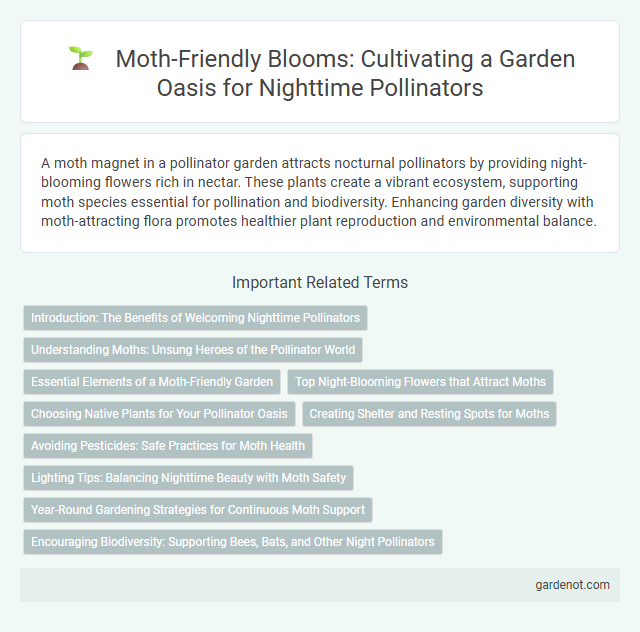A moth magnet in a pollinator garden attracts nocturnal pollinators by providing night-blooming flowers rich in nectar. These plants create a vibrant ecosystem, supporting moth species essential for pollination and biodiversity. Enhancing garden diversity with moth-attracting flora promotes healthier plant reproduction and environmental balance.
Introduction: The Benefits of Welcoming Nighttime Pollinators
Moth magnet plants attract essential nighttime pollinators, increasing biodiversity and promoting healthy ecosystems within pollinator gardens. These plants support nocturnal species that contribute to the pollination of various flowers, enhancing fruit and seed production. Incorporating moth-attracting flora like evening primrose and nicotiana enriches garden vitality by extending pollination activity beyond daylight hours.
Understanding Moths: Unsung Heroes of the Pollinator World
Moths play a crucial role in pollination, particularly for night-blooming plants that rely on these nocturnal pollinators to transfer pollen. Their hairy bodies efficiently collect and disperse pollen grains, supporting biodiversity and ecosystem health. Recognizing moths as unsung heroes highlights the importance of creating moth magnets within pollinator gardens to attract and sustain these vital species.
Essential Elements of a Moth-Friendly Garden
A moth-friendly garden thrives with essential elements such as night-blooming flowers rich in nectar, like evening primrose and nicotiana, which attract diverse moth species. Providing native plants supports local moth populations by offering suitable host plants for caterpillars, ensuring lifecycle sustainability. Soft lighting and sheltered areas reduce disturbance, creating an ideal habitat for moths to feed, mate, and lay eggs.
Top Night-Blooming Flowers that Attract Moths
Top night-blooming flowers that attract moths in a pollinator garden include the fragrant Evening Primrose, Sweet Jasmine, and Moonflower, which produce strong nocturnal scents and pale colors that effectively lure moths. These plants provide critical nectar sources essential for moth pollinators, supporting biodiversity and enhancing nighttime garden activity. Incorporating these moth magnets helps sustain healthy pollinator populations while increasing nighttime pollination efficiency.
Choosing Native Plants for Your Pollinator Oasis
Selecting native plants for your pollinator garden enhances the effectiveness of creating a moth magnet by providing familiar nectar sources and host plants tailored to local moth species. Native flora attracts a diverse range of nocturnal pollinators like sphinx moths and hawk moths, supporting their life cycles and boosting pollination rates. Prioritize native night-blooming plants such as evening primrose, moonflower, and wild petunia to establish a thriving moth habitat rich in nectar and shelter.
Creating Shelter and Resting Spots for Moths
Moth magnets play a crucial role in pollinator gardens by providing essential shelter and resting spots for moths, supporting their lifecycle and nocturnal activities. Incorporating native plants with dense foliage and creating layered vegetation structures enhances moth habitat suitability, increasing biodiversity. Strategic placement of sheltered areas protects moths from predators and harsh weather, fostering a thriving moth population essential for nighttime pollination.
Avoiding Pesticides: Safe Practices for Moth Health
Avoiding pesticides in moth magnet gardens ensures the health and survival of beneficial moth species that contribute to pollination. Using organic methods like neem oil or insecticidal soaps protects moth larvae and adults from toxic exposure. Maintaining pesticide-free zones supports diverse pollinator populations and promotes ecological balance in garden ecosystems.
Lighting Tips: Balancing Nighttime Beauty with Moth Safety
Moth magnets use UV or blue LED lights to attract moths, requiring careful placement away from busy areas to prevent disturbance. Installing dimmable lights and using motion sensors can minimize excessive illumination, preserving nighttime darkness essential for moth navigation and safety. Selecting lights with wavelengths that attract moths without overwhelming artificial brightness supports a thriving pollinator garden ecosystem.
Year-Round Gardening Strategies for Continuous Moth Support
Planting a variety of night-blooming flowers such as evening primrose, nicotiana, and jasmine ensures continuous nectar sources for moths throughout the year. Incorporating native host plants like oak and willow trees provides essential larval food to sustain moth populations across seasons. Maintaining moist soil and avoiding pesticides further supports healthy moth habitats in year-round pollinator gardens.
Encouraging Biodiversity: Supporting Bees, Bats, and Other Night Pollinators
Moth magnets are essential for encouraging biodiversity by attracting nocturnal pollinators such as moths, bats, and other night-active insects. These creatures contribute significantly to pollination, supporting the health of native plants and agricultural crops. Integrating moth-friendly plants and features enhances nighttime pollination, promoting ecosystem resilience.
Moth magnet Infographic

 gardenot.com
gardenot.com